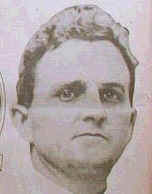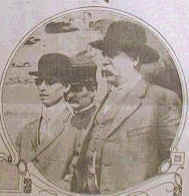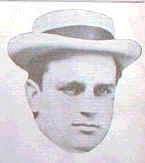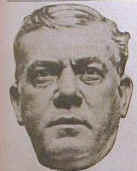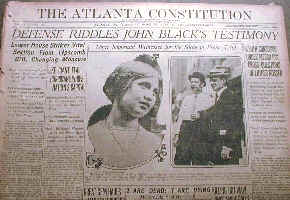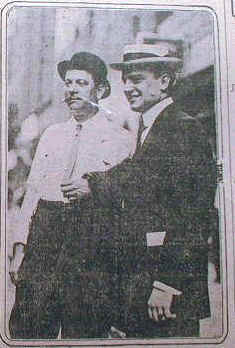The Leo Frank case
Murder in Georgia - 1913
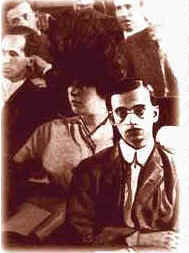 |
Leo Franks drugged 13 yr. old Mary Phagan and
then brutally raped and murdered her. Franks gave the janitor $
200 to burn the body in the factory furnace. He was convicted to hang .. the sentence was
commuted.
A mob , organized by Marietta finest families , broke into jail and
drove him 170 miles back home and hung him.
Today the Jewish community hails Leo Franks as a innocent martyr - a
victim of anti-Semitism |
| The
Victim |
 |
Mary Phagan, a 12 yr. old employee of
the National Pencil Factory in Atlanta, was murdered .
|
The murderer |

|
Leo Frank Frank was a Cornell-educated Jew raised in New York City,
living in Atlanta. President of his local B'nai Brith, active in civic affairs, he was
supervisor at the National Pencil Factory, where Phagan worked.
Frank was well known as a sexual deviate that forced employees to have
sex. |
The murder
12 years old
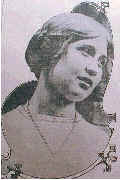
|
April 26th, 1913 - Conley said Frank had
asked him to "watch out" for him while he "chatted" with Mary Phagan.
He then supposedly told Conley that Phagan had refused him and he had struck her
and left her in the machine room. On the day of the murder, Conley went on, he
came into the office and found Leo crouching over the unconscious girl. Leo told him that
Mary had resisted his advances, and when he grabbed her had fallen and struck her head.
When he had finished with her he decided to kill her. So he strangled her to death with
the cord.
Frank tried to get Conley to burn the body in the factory's
basement furnace.
Conley said Frank told him to wrap up the body and put it in the
basement. Conley tried to do so, but said he could not lift the body. |
| So Frank had helped
him get it on the elevator, which they then took to the basement, where Conley dragged the
body into a corner. They then returned to Frank's office, where Frank indicated there
would be money waiting for Conley if he "kept his mouth shut. "
Here Frank uttered the ominous phrase "Why should I
hang?"
Frank then had Conley write the notes found near the body, apparently in
an attempt to incriminate Newt Lee.
Newt Lee discovers the body and calls the police. The police found the body black from
cinders and dirt. One eye had been blackened by a blow. Over both eyes was a slight
abrasion. The left side of the head bore a two-inch wound, and there was a cut below the
left knee. Drawn tightly about her neck was a cord buried in the flesh.
The girl had been beaten and strangled; and she had been raped.
|
Newt Lee |
The night watchman who discovered Mary
Phagan's body and telephoned police. |

|
He testified for over two hours, telling the same story he
had told police, that he noticed the body when he went into the basement to the restroom.
He also told of Leo Frank being nervous. That night, Frank called
Lee to ask if everything was alright, an unusual practice for him. |
| Jewish
involvement |
 |
ADL formed
Soon thereafter the Anti-Defamation League of B'nai B'rith was founded in New York; its
founding was based largely on the Leo Frank case and its aftermath. Ironically, Leo Frank had been president of the Atlanta chapter of B'nai B'rith. |
Banai Brith employs senator
June 24, 1913 - Georgia senator Hoke Smith
denied rumors he had been approached about and was considering aiding in Leo Frank's
defense. The rumors spread after defense attorney Luther Rosser and National Pencil
Company president Ike Haas stopped in Washington, D.C. en route to New York. |
|
Body exumed |
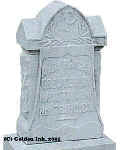
|
May 5, 1913 - Lemmie Quinn, foreman of
Mary Phagan's work area at the National Pencil Factory, testified he saw Leo Frank the
Saturday of the murder and he appeared to be on drugs. So the decision was
made to exhume Phagan's body and search her stomach for signs of drugs. |
 |
Alibi broken May
9, 1913 - Fourteen year old Monteen Stover said she had arrived at the National Pencil
Factory around 12:05 PM (roughly the same time as Mary Phagan had arrived) and that Leo
Frank was not in his office. This contradicted Frank's testimony that he had been in his
office the entire time in which it was thought Phagan had been murdered.
Another woman reported that she was walking outside the factory around
4:30 PM when she heard three piercing screams come from the basement of the building.
|

|
The prosecutor May
21, 1913 -
Solicitor Hugh Dorsey announced that he would go before the grand jury
on May 23rd and ask for indictment on Leo Frank and that the evidence presented would
concentrate on Frank. |
 |
Jewish lawyers accussed of bribing detectives May 22 a new controversy arose in the Mary Phagan murder investigation.
Phagan's step father signed an affidavit accusing Thomas Felder, the attorney responsible
for bringing the Burns Detective Agency into the case, of approaching him about allowing
Felder to prosecute the case.
Detectives presented transcripts of dictograph recordings in which
Felder had offered them $1000 for access to the case evidence. |
| May 23 - The
grand jury took only ten minutes to hand down a murder indictment against Leo
FrankOn May 24, 1913, the grand jury indicted Leo for the murder of Mary Phagan,
largely on the testimony of Conley, and held the Negro as an accessory. There were five
Hebrews on this grand jury. |
Body exhumed 2nd
time |
 |
May 25, 1913 - A second exhumation of Mary Phagan's body
took place, this time to look for fingerprints; a fingerprint expert had been called in to
help with the case.
The undertaker who embalmed Phagan's body said there was evidence of
sexual assault and the county physician said there was evidence of a sexual assault. |
| Family cook testifies about Frank's
confession and attempted bribery |
| Minola McKnight 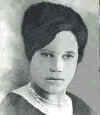
|
June 3 - Minola McKnight, the Frank family
cook signed a statement saying Leo frank was very nervous and drinking heavily the
night after the murder of Mary Phagan. She said she overheard Frank's wife say he made her
sleep on the rug and kept asking for his pistol so he could shoot himself.
Frank had told her
-- "It is mighty bad, Minola. I might have to go to jail
about this girl, and I don't know anything about it."
Finally she said her wages had been raised as a " tip to keep
quiet." |
Trial
begins
July 28, 1913
A jury was quickly selected and seated. The first witness
called was Mrs. J.W. Coleman, mother of Mary Phagan. She managed to stay collected
during most of her testimony, but finally broke down in tears when asked to identify the
clothes her daughter had worn on the day she was murdered.
Next on the stand was George Epps, a thirteen year old boy
who also worked at the National Pencil Factory. He had ridden the streetcar with Phagan
the morning of April 26th, and the two had agreed to meet for an ice cream and to watch
the Confederate Memorial Day Parade at 1:00 that afternoon. |
Leo Frank's various
alibi's |

|
A Jewess lies
Lucille Frank June 2, 1913 - At first she
corroborated Frank's story concerning the times he arrived home for lunch and then
returned to the factory the day of the murder. She was agitated, believing her estranged
husband had been telling lies to the police to get her in trouble. She said both she and
Frank were innocent. |

|
Jewish assistant
Herbert Schiff August
9, 1913 - the twelfth day in the Leo Frank trial. Herbert Schiff, Jewish assistant to Leo
Frank, said he worked most Saturdays and had never seen any women in Frank's office except
his wife. He added that he had never seen C.B. Dalton either. |
|

|
Witnesses tampering revealed May 7, 1913 - The wife of one of the mechanics who had testified on April
30 said she visited her husband at the factory that day and saw a "strange
Negro" boarding the elevator as she left around 1:00 PM. Detectives on the case said
someone was planting false evidence and trying to block the investigation. |

|
Murderer hires the investigators
Leo Frank of the National Pencil Factory expressed his unhappiness
with the investigation's progress, so he personally brought in a Pinkerton's detective to
aid in the investigation. |
 |
Devastating witness This was the seventh, and pivotal, day in the trial of Leo Frank. Jim
Conley, a sweeper at the factory, was called to testify and presented a gruesome, graphic,
and sometimes revolting tale.
In fact his testimony was so lurid that Judge Roan
ordered all women and children cleared from the courtroom.
Conley testified he had "watched out" for Frank on several
occasions, while he entertained young women in his office. |
| Trial On the witness stand,
Jim Conley was, unfortunately for Frank, devastating. According to Conley, Frank had
confessed the murder to him and had tried to get him, (Conley), to burn the body in the
factory's basement furnace. Frank's lawyers were unable to shake Conley's story, and Frank
himself was hesitant and unconvincing on the stand, and his denial carried little weight. Some of his descriptions of what he saw intimated that Frank was a sexual deviant. On the morning of April 26th, Conley
said Frank had asked him to "watch out" for him while he "chatted"
with Mary Phagan. Later, Frank had whistled for Conley to come to his office. Frank was so
nervous he had to lean on Conley for support.
He then supposedly told Conley that Phagan had refused him and he had
struck her and left her in the machine room. When Conley was sent to get her, he said he
found her lying on the floor, dead, with arms outstretched. Conley said Frank told him to
wrap up the body and put it in the basement. Conley tried to do so, but said he could not
lift the body.
So Frank had helped him get it on the elevator, which they then took to
the basement, where Conley dragged the body into a corner. They then returned to Frank's
office, where Frank indicated there would be money waiting for Conley if he "kept his
mouth shut." Here Conley said Frank uttered the ominous phrase "Why should I
hang?" Frank then had Conley write the notes found near the body, apparently in an
attempt to incriminate Newt Lee. |
John Starnes

|
Detective Starnes said he found the body in the basement,
face down, with a cord tied tightly around the neck, and a pair of women's underpants tied
loosely around the neck. The back of the head was covered in
blood. He had called Leo Frank to inform him of the murder, and said Frank appeared
extremely nervous when he arrived at the factory. . |
Harry Scott

|
Pinkerton detective in charge of their investigation of the
case. Scott then angered defense attorneys when he asserted one of
them had asked him to forward all police evidence to the defense. Also testifying was
former factory employee Monteen Stover, who said she had arrived at the factory at 12:05
PM to receive her pay, had waited in Frank's office for him for five minutes, then left.
This contradicted Frank's statement that he had been in his office the entire time in
which the murder took place. |
A few minor witnesses were then called. Dr. J.W. Hurt, county physician
who had also examined Mary Phagan's body, said there was some evidence suggesting she may
have been "outraged" (sexually assaulted), there was not enough evidence to
conclude this. Another factory employee and friend of Mary Phagan, Helen Ferguson,
testified she had gone to the factory Friday night to get Mary's pay envelope, but Leo
Frank had told her Mary would pick it up herself on Saturday.
| Jim Conley |
Negro acts as a ' Lookout ' |
 |
Summarized, Conley's story was to the effect that he had often sat outside
Leo's office as a sort of watchdog while Leo staged his perversions behind the locked
door. When anybody would approach, Conley would whistle or cough to warn his employer. |
|
| August 5, 1913 When the day ended Conley was still
on the stand, while defense attorneys argued that his testimony of having been a lookout
for Frank on earlier occasions should be stricken from the record as irrelevant to the
case. August 6, 1913 - this was the ninth day of the
trial of Leo Frank. Judge L.S. Roan ruled that testimony that Jim Conley had acted as a
lookout for Leo Frank was admissible.
Applause broke out in the courtroom; Frank's attorneys immediately
contended that any further such actions would be cause for a mistrial; Judge roan
threatened to clear the courtroom if order was not maintained. |
|
Frank's mother

|
August 13, 1913 - . Jim Conley had claimed he watched while
Frank entertained a woman in his office that day. More character witnesses were called
during the afternoon. In cross-examining one of these witnesses, Hugh
Dorsey asked if he had ever heard complaints about Frank fondling young girls. Mrs. Rae Frank, Leo Frank's mother, leapt to her feet and shouted at Dorsey "No,
nor you either, you dog."
One of the defense attorneys escorted Mrs. Frank out of the courtroom.
|
| Leo Frank testifies |
|

|
August 18, 1913 - Leo Frank took the witness stand.
He spoke for four hours, calmly but firmly laying out his story. Frank said Jim Conley's
tale was all lies, and that the detectives tried to distort everything he (Frank) said in
order to incriminate him. . He said Mary came in for her pay soon
after 12:00 noon on April 26th, returned a few minutes later to ask if the shipment of
metal had arrived (Phagan's job was putting metal tips on pencils), then left his office
and he never saw her alive again. |
| He never saw Jim Conley that day. Frank
concluded his statement thus: "Some newspaper man has called me 'the silent man in
the Tower.' (for his unwillingness to talk to police or the press) Gentlemen, this is the time and here is the place! I have told you the
truth, the whole truth, and nothing but the truth." |
Prosecutor's final arguement
August 23, 1913 - the twenty-fourth day in the trial of Leo Frank.
Solicitor Hugh Dorsey continued
his eloquent, yet ferocious, final argument, scoring Leo Frank for
his abhorrent behavior and contending that he could not careless what opposing attorneys
or Frank's family thought of him; his duty was to Mary Phagan and the people of Georgia.
Defense cries ' Anti-Semitism '
August 25, 1913 - The defense then argued that Frank was the latest in a
long line of Jews who werepersecuted for their religious beliefs, and again asserted that
Jim Conley was the true murderer. Conley, and many other prosecution
witnesses, had shady characters, while Leo Frank had been a pillar of the community who
had many well respected people, plus many of his employees, testifying on his behalf. If
the case came down to Leo Frank's word against Jim Conley's, then it was obvious who
should be believed.
The verdict |
Jury decides |
|
 |
Monday morning the Fifth Regiment, Georgia
National Guard, was posted throughout the city, and Judge Roan gave the jurors their
instructions. Both sides have admitted that the charge was impartial and fair.
To avoid a riot, at Roan's suggestion neither Frank nor his lawyers were in court when
the jury retired. It remained secluded for forty minutes. |
| There were two ballots; one, as
to Leo's guilt, which was unanimous; and the second, as to recommendation for mercy, which
would mean a life sentence. The first vote here was 11 to 1 against leniency, and the
solitary juror then joined the others. |
Georgia
State Militia was called out in case Leo Franks was acquitted |
 |
Verdict delivered At 4:55 they returned with their decision; Leo Frank was declared guilty. Neither
Frank nor his family or lead attorneys were present in the courtroom when the verdict was
announced.
Reportedly Judge Roan feared mob violence should Frank have been
acquitted. |
Leo Frank sentenced |
 |
August 26, 1913 - Judge L.S. Roan sentenced Leo Frank to hang for the murder of Mary Phagan. The execution date was set for October 10, but Frank's attorneys immediately
motioned for a new trial. |
|
Governor commutes sentence |
Governor
flees for his life

|
June 20, 1915 In his
last day in office, Georgia governor John Slaton commuted the
sentence of Leo Frank, from death to life in prison.
Governor Slaton announced the commutation from hanging to life imprisonment --and hell
broke loose in Atlanta.
The militia was called out and thrown around the governor's mansion, seven
miles from the heart of the city, and martial law was declared. Hundreds of automobile
loads of armed men raced through the streets to the executive home, where the mob trampled
the grounds, screamed at the curtained windows, and hurled itself vainly against the
militia's bayonets |
| He was influenced by his law partners, who
represented Frank. Either way, Slaton's act was political suicide. He was forced to
leave the country in fear for his own life. The issue was now "Georgia's traitor
governor who sold out to sheeny gold." Slaton was hanged in effigy; and the rumor
that he and Mrs. Slaton were leaving at once for New York caused the throng to scream
imprecations. |
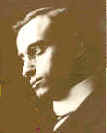 |
Frank stabbed in prison June 21, 1915 - Leo Frank, in the middle of the night, was transferred from
the Fulton County Prison to the Georgia State Penitentiary in Milledgeville
July 18, 1915 - Prisoner J. William Creen slashed Leo Frank's throat at
the Georgia State Prison Farm in Milledgeville. Only the quick actions of two other
prisoners, both doctors, who stopped the flow of blood and stitched the wound, saved
Frank's life. |
|
|
| The lynching |
| Lynch
mob of leading citizens gathers |
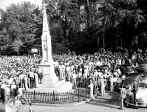
|
Lynching mob
consisted of leading citizens in the community, men prominent in business and social
circles, and even in churches." August 16, 1915 - A caravan
of eight vehicles bearing 25 armed men from the Atlanta area arrived at the Georgia
StatePrison at Milledgeville around 10 p.m. |
| Calling
themselves the Knights of Mary Phagan, they cut the telephone lines, surprised the
guards and entered the barrack of Leo Frank, who two years earlier had been convicted of
the murder of 14-year-old Mary Phagan in one of the most infamous trials of the century.
The intruders seized Frank and departed into the night. |
| Leo
Frank lynched |
 |
August 17, 1915 - Whatever the truth may
be, Frank was hanged there in Frey;s grove. When word of the lynching spread,
crowds gathered to see the body hanging from a tree. Photographs were taken, one of which
later became a souvenir postcard. The next
morning, a farmer driving his team and wagon of produce into Marietta, 170 miles away, saw
a man dangling from a tree near the roadway. He recognized Leo Frank, hanging in his
silk nightgown, a hangman's noose beside his tilted jaw. He had been dead for several
hours.
The farmer whipped up his horses and a little later a mob of 6,000 men and boys was
crowding the highway for a look as the famous prisoner
A few in the crowd threatened, and even began to inflict, violence
to Frank's body, before former judge Newt Morris convinced them to
stop. |
| Frank's body was rushed to
an undertaker in Atlanta, with a line of vehicles trailing behind.
Although the undertaker tried to keep the body concealed,
a large crowd soon gathered demanding to see it. After a rock was thrown through a
window, officials agreed to let the public view Frank's body. Under police supervision, thousands ofcurious Atlanta-area residents filed by
single file to view Frank's body -- including the city detective whohad arrested Frank.
That night Frank's body was quickly embalmed and placed on a train for New York.
August 18, 1915 - Leo Frank's body, accompanied by his wife, departed
Atlanta on a train bound for Brooklyn, NY.
August 20, 1915 - Leo Frank was buried in Brooklyn, NY.
* As a footnote to the lynching, no one
was ever prosecuted for the murder of Leo Frank. |
Mary Phagan's grave
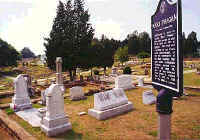
A website now claims to
identify the lynchers of Leo Frank - June 12, 2000
Idenity of lynchers
http://www.blackmask.com/books52c/mystpenc.htm
